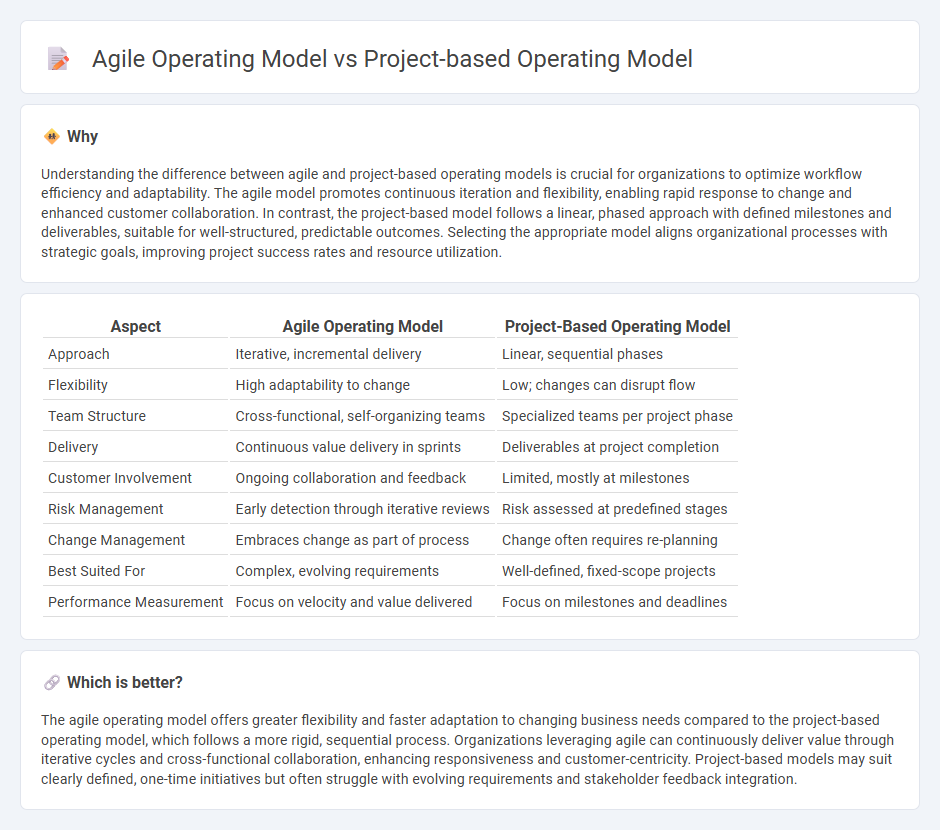
Agile operating models emphasize flexibility, iterative development, and cross-functional collaboration to rapidly adapt to changing market demands, unlike traditional project-based models focused on linear phases and predefined deliverables. Organizations leveraging agile frameworks such as Scrum or SAFe achieve faster time-to-market, improved stakeholder alignment, and enhanced innovation capacity. Explore how transitioning to an agile operating model can drive sustained competitive advantage in your business.
Why it is important
Understanding the difference between agile and project-based operating models is crucial for organizations to optimize workflow efficiency and adaptability. The agile model promotes continuous iteration and flexibility, enabling rapid response to change and enhanced customer collaboration. In contrast, the project-based model follows a linear, phased approach with defined milestones and deliverables, suitable for well-structured, predictable outcomes. Selecting the appropriate model aligns organizational processes with strategic goals, improving project success rates and resource utilization.
Comparison Table
| Aspect | Agile Operating Model | Project-Based Operating Model |
|---|---|---|
| Approach | Iterative, incremental delivery | Linear, sequential phases |
| Flexibility | High adaptability to change | Low; changes can disrupt flow |
| Team Structure | Cross-functional, self-organizing teams | Specialized teams per project phase |
| Delivery | Continuous value delivery in sprints | Deliverables at project completion |
| Customer Involvement | Ongoing collaboration and feedback | Limited, mostly at milestones |
| Risk Management | Early detection through iterative reviews | Risk assessed at predefined stages |
| Change Management | Embraces change as part of process | Change often requires re-planning |
| Best Suited For | Complex, evolving requirements | Well-defined, fixed-scope projects |
| Performance Measurement | Focus on velocity and value delivered | Focus on milestones and deadlines |
Which is better?
The agile operating model offers greater flexibility and faster adaptation to changing business needs compared to the project-based operating model, which follows a more rigid, sequential process. Organizations leveraging agile can continuously deliver value through iterative cycles and cross-functional collaboration, enhancing responsiveness and customer-centricity. Project-based models may suit clearly defined, one-time initiatives but often struggle with evolving requirements and stakeholder feedback integration.
Connection
The agile operating model and project-based operating model are connected through their focus on iterative delivery and adaptability to change, enabling continuous improvement in consulting projects. Agile frameworks, such as Scrum or Kanban, provide project-based teams with structured yet flexible approaches to planning, execution, and feedback, enhancing collaboration and responsiveness. This integration supports faster decision-making, risk mitigation, and alignment with client goals, driving successful project outcomes in dynamic consulting environments.
Key Terms
Fixed Scope vs. Iterative Delivery
A project-based operating model centers on delivering a fixed scope with predefined requirements and timelines, ensuring clear milestones and budget control. In contrast, an agile operating model emphasizes iterative delivery, allowing continuous feedback, adaptability, and incremental value creation throughout the project lifecycle. Explore the distinctions and benefits of each approach to optimize your organization's project management strategy.
Milestone Planning vs. Continuous Feedback
The project-based operating model emphasizes Milestone Planning, setting predefined goals and deadlines to measure progress and ensure timely delivery. The agile operating model prioritizes Continuous Feedback, enabling iterative development and rapid adaptation based on stakeholder input and changing requirements. Explore deeper insights to determine which model best suits your organization's workflow and efficiency objectives.
Resource Allocation vs. Cross-functional Teams
Project-based operating models prioritize resource allocation by assigning specific personnel and budget to discrete projects, ensuring clear accountability and efficient use of specialized skills. Agile operating models emphasize cross-functional teams that collaborate iteratively, promoting flexibility and rapid response to changing project needs. Explore the differences in these operating models to optimize your organization's workflow and productivity.
Source and External Links
A Shift From Project Centric Operating Model to Product Centric Operating Model - Explains that a project-based operating model focuses on delivering projects with defined scopes, but in today's fast-changing markets, a product-centric model is needed to continuously align with customer demands and enable agility through ongoing product backlog management instead of fixed project plans.
How to create a product operating model to support product organization transformation - Describes that a product operating model (POM) is designed around product lifecycle management rather than projects, fostering responsiveness and resilience by focusing on outcomes; project modes still apply when scope is clear, but product models suit dynamic, digital businesses better.
Bottom-line benefit of the product operating model - Highlights a case where shifting from a project-based to a product-based operating model with cross-functional autonomous teams improved innovation speed by 60% and customer focus by 20%, demonstrating tangible business value in agility and growth.
 dowidth.com
dowidth.com